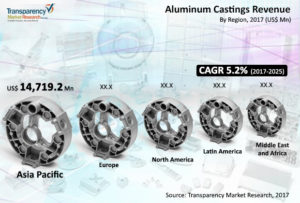Excitement About Aluminum Castings Company
Table of ContentsAluminum Castings Company Things To Know Before You Get ThisThe Only Guide to Aluminum Castings CompanyUnknown Facts About Aluminum Castings CompanyThe 5-Second Trick For Aluminum Castings CompanyAluminum Castings Company for BeginnersGetting My Aluminum Castings Company To WorkAluminum Castings Company Can Be Fun For AnyoneWhat Does Aluminum Castings Company Mean?
There are 2 main kinds of die spreading utilized in the aluminum casting market: warm chamber die casting and chilly chamber pass away casting. The key distinction in between these approaches is just how the molten metal is supplied to the mold. In warm chamber die spreading, typically used for lower melting point steels, the melting pot is directly attached to the equipment, and a bettor compels the product via a gooseneck right into the die dental caries.
The Facts About Aluminum Castings Company Uncovered
In these approaches, the mold is intentionally ruined or escaped in order to remove the finished light weight aluminum casting. Common processes under the category of expendable mold spreading consist of (financial investment spreading),,, and financial investment spreading. When making personalized aluminum parts making use of expendable molds, suppliers pour molten light weight aluminum or aluminum alloys right into the mold, which is then busted apart to launch the solidified metal component.
The is one of the oldest and most utilized types of aluminum casting. It involves compacting specialized foundry sand, typically enhanced with clay or resin, around a precisely crafted multiple-use pattern that figures out the form and internal details of the completed light weight aluminum product. The pattern system includes risers and vents to handle the flow of liquified metal and to avoid casting problems such as shrinking porosity.
The Ultimate Guide To Aluminum Castings Company

This mold and mildew is then preheated previous to the putting of liquified aluminum or aluminum alloy. As the metal loads the covering, it catches the detailed details and great surface finish of the mold. When cooled down, the ceramic is mechanically or chemically escaped, allowing for the elimination and separation of individual actors components.
9 Simple Techniques For Aluminum Castings Company
Irreversible mold and mildew spreading makes use of multiple-use steel molds and is excellent for mass production with regular quality and much less waste. Expendable mold casting uses single-use mold and mildews, like sand or foam, supplying style adaptability and reduced tooling expenses for models or brief runs. Die spreading is best for creating high quantities of aluminum components that require limited resistances, fine information, and smooth surface areas.
The Toshiba Equipment DC-J Series consists of die casting equipments ideal for aluminum. Recognized for their robust building and high injection performance, these makers ensure reliable and exact spreading (Aluminum Castings).

While aluminum can be used in its pure kind, it is commonly alloyed with other metals to boost its homes or the residential properties of the other metals. These alloys supply improved efficiency for numerous applications. Light weight aluminum alloys are classified right into eight collection, numbered from one to 8. The first digit(s) of the number suggest the main alloying element incorporated with light weight aluminum.
The 4-Minute Rule for Aluminum Castings Company
This alloying boosts the strength and hardness of light weight aluminum however lowers its ductility and Your Domain Name deterioration resistance. The 2000 series alloys are testing to weld yet can be heat dealt with to improve their residential properties. The 3000 collection alloys are largely alloyed with manganese. This mix enhances deterioration resistance while giving modest stamina.
The 4000 series alloys are alloyed with silicon, which lowers the melting point and boosts fluidness. This makes it a preferred option for spreading, as it is easy to form in its molten state.
Not known Incorrect Statements About Aluminum Castings Company
This collection is identified as a high-strength alloy, specifically suited for sheet and plate applications as a result of its excellent weldability. Its resistance to deterioration from acids and alkalis makes it suitable for usage in severe and hostile environments (Aluminum Castings). The 6000 series alloys are alloyed with both magnesium and silicon, providing an equilibrium of strength, mechanical residential or commercial properties, and deterioration resistance
Handling the 6000 collection requires specialized and sophisticated equipment, which can be intricate and expensive. However, this series is recognized for its exceptional rust and oxidation resistance, along with its ease of finish, treatment, and workability. The 7000 collection light weight aluminum alloys are the strongest and most long lasting among aluminum types, with strength similar to around two-thirds of industrial-grade A3 steel.
Fascination About Aluminum Castings Company
Zinc is the primary alloying aspect in the 7000 series, enhancing the solidity of the light weight aluminum, despite the fact that zinc's solidity is comparable to that of light weight aluminum on the Mohs scale. The 8000 collection aluminum alloys are mainly alloyed with tin, in addition to percentages of copper and nickel (Aluminum Castings Company). While these alloys use reduced stamina compared to other collection, they stand out in machinability and wear resistance
Light weight aluminum cast heatsinks are electrically conductive, enabling them to be grounded properly. They are usually cast with incorporated attributes that minimize the demand for second procedures, such as extra machining or setting up, leading to more price savings. Aluminum casting is regularly made use of to produce brackets for both durable commercial equipment and home home appliances.
More About Aluminum Castings Company
The single-piece building and construction of aluminum brackets enhances their stamina and sturdiness, minimizing the chance of failure. If openings are required, they can be consisted of directly in the casting mold, lessening the requirement for post-production completing (https://www.brownbook.net/business/54468848/aluminum-castings-company). Suppliers have actually increasingly taken on aluminum spreading for golf tools as a result of its durability, stability, and adaptability in shaping